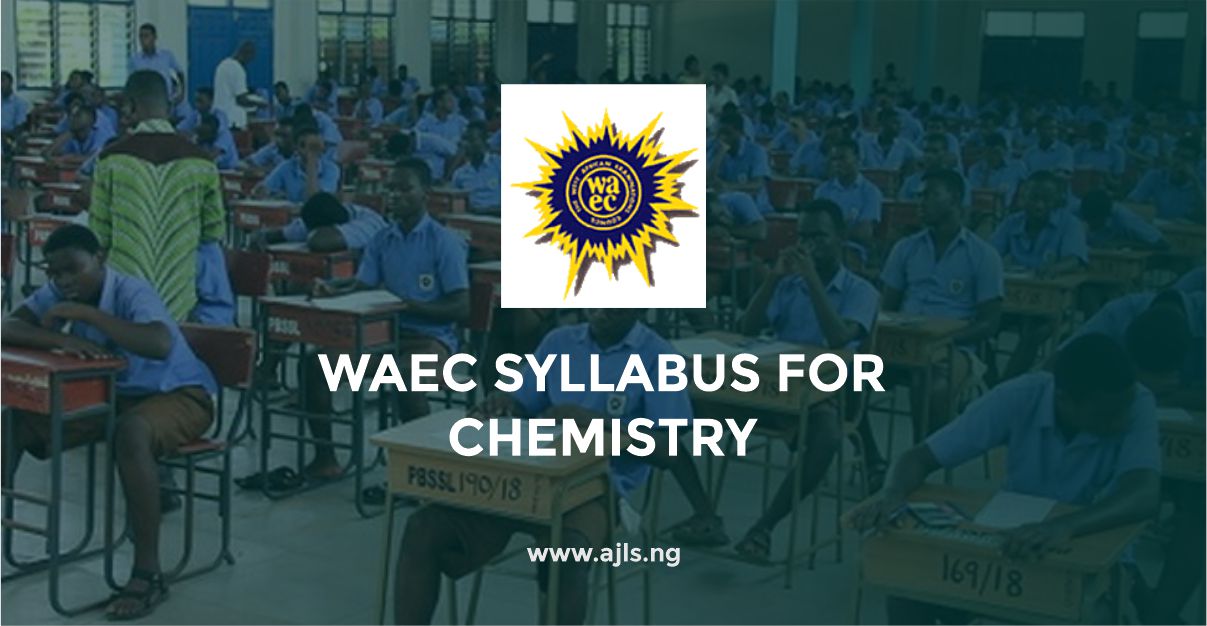WAEC Syllabus for Chemistry 2025

The West African Examinations Council (WAEC) has provided a comprehensive syllabus for Chemistry to help students prepare for the upcoming examination. Note that the syllabus relates to art, science, or commercial students in every secondary school in the country.
Do you need the WAEC Syllabus for Chemistry? Congratulations! You are on the right page. The chemistry syllabus is designed to provide students with the necessary knowledge, practical skills, and scientific reasoning required to excel in their examinations.
The WAEC Syllabus for Chemistry is subdivided into three broad sections: Physical Chemistry, Inorganic Chemistry, and Organic Chemistry. Each section covers key topics that will be tested in both theory and practical examinations. In this guide, we will cover all the essential topics, practical requirements, and exam tips to help you prepare effectively. Read Carefully Below.
WAEC Syllabus for Chemistry
Below is a well-structured guide to the WAEC Syllabus for Chemistry. First on our list is physical chemistry. See details below on the topics included in it.
1. Physical Chemistry
This section deals with the fundamental principles that govern chemical reactions and the behavior of matter. Topics include:
States of Matter
- The three states of matter: solid, liquid, gas
- Properties of gases (Boyle’s law, Charles’s law, Avogadro’s law, and the Ideal Gas Equation)
- Changes of state: melting, boiling, evaporation, sublimation
- Diffusion and Brownian motion
Atomic Structure and the Periodic Table
- Subatomic particles: Protons, neutrons, and electrons
- Electronic configuration and atomic orbitals
- The Periodic Table: Groups, periods, and periodic trends (atomic size, ionization energy, electron affinity, and electronegativity)
Chemical Bonding
- Types of bonding: Ionic, covalent, and metallic bonds
- Bonding theories: Valence shell electron pair repulsion (VSEPR) theory, hybridization
- Intermolecular forces: Hydrogen bonding, dipole-dipole interactions, and Van der Waals forces
Chemical Reactions and Stoichiometry
- Balancing chemical equations
- The mole concept and Avogadro’s number
- Empirical and molecular formulae
- Stoichiometric calculations (mass, volume, and gas laws)
Energetics (Thermochemistry)
- Exothermic and endothermic reactions
- Enthalpy changes (heat of reaction, combustion, formation, and neutralization)
- Hess’s Law and bond enthalpies
Rates of Reaction and Chemical Equilibrium
- Factors affecting the rate of reaction (temperature, concentration, surface area, catalysts)
- Collision theory
- Le Chatelier’s Principle and equilibrium constant (Kc and Kp)
Electrochemistry
- Electrolysis: Mechanism, Faraday’s laws, and applications
- Electrochemical cells (galvanic and electrolytic cells)
- Standard electrode potentials and redox reactions
2. Inorganic Chemistry
This section focuses on the chemistry of elements, their compounds, and their periodic trends.
Periodic Table and Periodicity
- Group properties: Alkali metals, alkaline earth metals, halogens, noble gases
- Transition metals: General characteristics, oxidation states, complex ions, and uses
Acids, Bases, and Salts
- Definitions (Arrhenius, Brønsted-Lowry, Lewis theories)
- pH scale and indicators
- Acid-Base Titration and Neutralization Reactions
- Preparation and properties of salts
Metals and Metallurgy
- General properties of metals and non-metals
- Extraction of metals from ores (Iron, aluminum, copper, zinc)
- Corrosion and methods of prevention
Non-Metallic Elements and Their Compounds
- Hydrogen: Properties, preparation, and uses
- Oxygen: Properties, preparation, and oxides
- Nitrogen and its compounds (Ammonia, Nitric acid, and fertilizers)
- Sulfur and its compounds (Sulfuric acid, industrial processes, and uses)
Water and Environmental Chemistry
- Composition and purification of water
- Hardness of water and its removal
- Pollution and its effects
- Green chemistry and sustainability
3. Organic Chemistry
This section covers the chemistry of carbon compounds, their reactions, and industrial applications.
Introduction to Organic Chemistry
- Structure and bonding in organic compounds
- Functional groups and homologous series
- Nomenclature of organic compounds
Hydrocarbons
- Alkanes, alkenes, and alkynes: Structure, properties, and reactions
- Isomerism in hydrocarbons (structural and geometric isomerism)
Alcohols, Ethers, and Carbonyl Compounds
- Properties and reactions of alcohols and phenols
- Aldehydes and ketones: Preparation and reactions
- Carboxylic acids and esters
Polymers and Macromolecules
- Addition and condensation polymerization
- Synthetic and natural polymers (Nylon, Terylene, proteins, and DNA)
Petrochemicals and Their Industrial Applications
- Fractional distillation of crude oil
- Uses of petroleum products
- Cracking and reforming
General Objectives of the WAEC Chemistry Syllabus
The syllabus aims to:
- Develop an understanding of the basic principles and concepts of Chemistry.
- Promote practical and analytical skills in problem-solving.
- Encourage the application of chemical knowledge in everyday life and industry.
- Develop an awareness of the impact of Chemistry on health, the environment, and technology.
Practical Chemistry
WAEC Chemistry also includes a practical examination that assesses candidates’ ability to perform laboratory experiments. Practical topics include:
- Qualitative analysis (identification of cations, anions, and gases)
- Titration (acid-base, redox titrations)
- Preparation of standard solutions
- Simple organic synthesis
Exam Format and Marking Scheme
The WAEC Chemistry exam consists of:
- Paper 1 (Objective Questions) – 50 multiple-choice questions (50 marks)
- Paper 2 (Theory Questions) – 2 sections: Physical, inorganic, and organic chemistry questions (100 marks)
- Paper 3 (Practical or Alternative to Practical) – Laboratory-based questions (50 marks)
Study Tips for WAEC Chemistry
To excel in the WAEC Chemistry exam, follow these study strategies:
- Focus on comprehension rather than rote memorization.
- Solve previous WAEC Chemistry questions to familiarize yourself with the exam pattern.
- Learn how to write and balance equations accurately.
- Allocate time for periodic review to reinforce learning.
- If possible, practice in a laboratory setting to enhance your practical skills.
Conclusion
The WAEC syllabus for Chemistry covers a wide range of topics that require thorough understanding and practical application. By following this comprehensive guide, focusing on key concepts, and practicing diligently, you can confidently prepare for the exam and achieve excellent results. Good luck with your WAEC Chemistry preparation!
Having provided a complete guide on the WAEC Chemistry syllabus and other necessary information you might need to prepare for the upcoming exams, now is the right time to start your registration.
Don’t forget to visit us regularly for a guide on the West African Examinations. We will not fail to post fresh updates and insight to ensure you excel in your exams. For your questions, please visit the comment section below, and we will reply as soon as possible.





